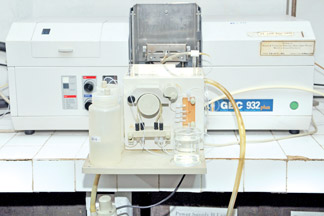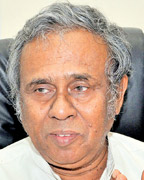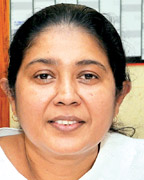|
Fatal illness in north central province claims 20,000
in 20 years:
Key to mystery killer disease found
by Manjula FERNANDO
|

Atomic Absorption Spectrophotometer the instrument used by the
research team to distinguish arsenic in the Agro chemicals Pix
by Chinthaka Kumarasinghe
|
Though just 45 years of age, the man looked ancient and feeble with
his ailing body. He looked up at the doctor in attendance at the Padavi
Sripura hospital with appealing eyes. Save me was registered in them. He
did not want to die. It was not the time.
As a poor farmer and a father of two girls of school-going age, there
was so much of unfinished business he could not leave behind. With an
uneducated but duty-bound wife, he was the sole bread winner of the
family.
In a neighbourhood where all his relatives and friends were farmers
he could only wish the two girls will grow up to marry strong men to
take over his land and continue the family tradition, paddy farming. He
could perhaps make up his mind then, to retire.
But the doctor knew better. By the look of his external and other
symptoms, acute asthma, swollen feet, lack of apetite and mostly the
dark hard patches on his feet were all but sure evidence that he had
caught the killer disease. The mystery kidney disease that had struck
the North Central province.
Two months after this encounter with Dr. Chintaka Wijewardena the man
passed away. He had been having the disease for a full six months before
he sought medical care.

Head of Kelaniya University’s Science Faculty Prof. Nalin de
Silva |

Head of Kelaniya University’s Chemistry Department Prof. Priyani
Paranagama |
Even if he visited the hospital before or if he received medical care
earlier, the doctors could have only delayed his death. So far no cure
has been found for this mystery killer disease.
The chronic kidney disease of unknown aetiology/origin (CKDu), which
is responsible for over 20,000 reported deaths in Anuradhapura and
Polonnaruwa districts has baffled doctors for the past 20 years.
Despite the fact that it has claimed thousands of lives for two
decades, the doctors could not find a cure or find as to what caused the
fatal disease. Although there had been many theories along the way,
nothing was corroborated by proof, until last week a bombshell was
dropped by a research team from the Kelaniya university.
The team which comprised chemists, pharmacologists, botanists,
medical doctors, judicial medical officers from Rajarata and Kelaniya
Universities finally unearthed the most crucial piece of evidence to
link the disease to the agro chemicals used by farmers in the area, in a
ground breaking research carried out for the past six months. They have
found the mystery disease was directly linked to arsenic poisoning!
Although the people vaguely suspected the agro chemicals having a
link to the mystery disease, there was hardly any concrete evidence to
pin it down.
The research which is yet to be acknowledged by the perpetrators,
established beyond doubt the presence of lethal compounds, arsenic and
mercury in disturbing proportions in the agro products, especially the
pesticides, manufactured and imported to Sri Lanka by multinational
companies, a clear violation of the country’s regulations.
|

Affected kidney |
They are at the moment in the process of confirming the link between
the disease and the chemicals. The team had not just succeeded in
establishing these facts but have come up with a new technique, for
which they plan to claim patent rights, to isolate and distinguish
arsenic in hard water (Kivul water), which was the key to their
findings.
The research team has tested eight different brands of agro chemicals
including that of two local products with the same disturbing results.
They proved the agro chemicals contained arsenic in alarming
proportions in the pesticides. The ‘hard water’ (kivul) present in the
area helped the arsenic to form calcium arsenate Ca3(ASO4)2 an extremely
poisonous chemical compound that is water soluble. The people of
Rajarata were most susceptible because of this unique quality in their
water.
Their research found the well water in the area contained a high
level of arsanic and the tank water too contaminated although showed
lower contents.
“We are 100 per cent sure that there are alarming proportions of
arsenic content in the agro chemicals imported to Sri Lanka. But we need
more tests to confirm that this is the cause for CKDu observed in
Rajarata,” Prof. Nalin de Silva told Sunday Observer when we confronted
him at his office at the Kelaniya University following the revelations
of their research.
He said arsenic is a class one poison which had been used from the
time of India’s King Asoka and also to kill Napoleon Bonaparte...
Arsenic is prohibited from use in pesticides according to Sri Lankan
law.
It had been a popular pesticide worldwide during the 1920s.
The head of the Science Faculty of the Kelaniya university and the
leader of the research team Prof. De Silva said there were evidence to
prove 99% that this was the cause for the mystery disease in Rajarata
but the tests were still continuing.
“We don’t have to wait long. The doctors from Rajarata conducting
tests on dead bodies of people who died of the disease are already
convinced the chemicals had killed these patients.”
Soon after the revelation of arsenic presence came out, the agro
companies, the biggest names in the global arena as well as here,
challenged the findings. The research team invited them to the Kelaniya
university and the tests were repeated in their presence.
Representatives of three companies turned up at the Science Faculty to
see the tests for themselves.
“It was a unprecedented move to allow them in our labs.
“Outsiders are not allowed under ordinary circumstances. But we did
it since lives were at stake. Following the tests they did not challenge
our findings.”
Head of Chemistry Department Prof. Priyani Paranagama, said they used
an internationally recognised method to distinguish arsenic in the Agro
chemical samples, water samples, soil, vegetation that included grass
and the bodies of the patients who died of the mystery kidney disease.
“The tests on agro chemicals proved that their products contained
arsenic levels ranging from 100 to 3000 micro grams per kilogram, which
is a highly lethal proportion capable of causing arsenic poisoning among
humans,” she said.
The arsenic, a waste product in gold and silver mining as well as
glass and computer chip-board production is used as a cheap source for
manufacturing pest control, herbicide and germicide intended for
countries like Sri Lanka.
However, the law here strictly prohibits the import of arsenic based
agro chemicals.
“This way they find a convenient dumping ground for their hazardous
waste in Sri Lanka but the irony is that we pay to get their waste
dumped here.”
Some argued that the soil in the area could have had arsenic presence
naturally. “There are countries like UK and Germany where arsenic is
naturally present in the ground soil.
But Sri Lanka is not one of them. Moreover, the arsenic traces were
found in the soil from the surface to about eight feet below. If arsenic
was present naturally it has to be there deep down as well,” Prof. De
Silva explained.
Others argued the kidney disease may have been caused by cadmium in
the chemical fertilizers used by farmers or by the high degree of
fluoride present in the soil. The research team had ruled out these
hypotheses.
Dr. Channa Jayasumana of the Rajarata University’s Medical Faculty
who initiated the research as part of his PhD work refuted this theory
saying if fluoride was the cause, the people of Hambantota and Ampara
should also have been affected by the disease.
Their theory is further supported by the fact that high concentration
of arsenic had been found in the extracts of liver, thyroid gland,
kidney, spleen and parts of the rectum of the bodies of patients who
have died of the disease.
Arsenic poisoning does not show off symptoms until the late stages,
thus by the time patients do turn up at the hospitals they are close to
death. The disease has no proven cure and this killer disease has
claimed many lives below 50, mostly the bread winner in the family,
rendering the families destitute.
“We found higher proportions of arsenic content in the body parts, it
was over 10-15 per cent higher than the WHO recommended levels,” Dr.
Chinthaka Wijewardena of Padavi Sripura Hospital who tested the dead
bodies assisted by a Judicial medical officer said.
Many of the patients who were diagnosed with the disease, have died
within 1-2 years of its, initial diagnosis.
The other medical complications that can be caused by arsenic
poisoning are heart attack, stroke, diabetes and weakened immune system
that may be manifested by recurrent attacks of viral flu.
Arsenic and Mercury are Class one carcinogens. Their entry to human
body could cause cancer. Further, mercury poisoning can harm the human
genetic structure resulting in abnormalies in new born babies in the
next generation. Dr. Wijewardena said a shocking 500 people out of the
tiny 10,000 population in Padavi Sripura have been diagnosed with this
killer disease. He has learnt 40 percent of deaths in this area during
the past five years were caused by the CKDu.
According to the Sri Lankan law, which harmonise with the
international law, no agro chemical manufactured using arsenic compounds
can be imported to Sri Lanka. Calcium arsenate had been a very important
agricultural insecticide in 1920s. But now its use is banned in many
countries and in some only restricted use is permitted due to adverse
implications to humans. Thus the results of their findings have now been
referred to the Controller of Pesticides’ for further action.
The research team says the agro companies had violated the law by
bringing in arsenic based products to the country. They alleged false
declarations have been made via laboratory test reports that were
submitted for approval from the Pesticide Controller.
The Controller of pesticides, alerted by the whistle blowing research
has referred the samples of Agro chemicals to the state’s accredited
laboratory, Industrial Technology Institute (ITI) for a review. The
report is expected within two weeks. The Controller of Pesticides can
recommend a ban on the products if the ITI tests corroborate the
findings of the scientists.
Meanwhile the Bio Diversity Unit of the Customs Department has
detained two consignments of the controversial Agro chemicals that was
to be cleared from the Harbour for distribution by two companies pending
the report of the Controller of Pesticides.
The research team
Prof. Nalin de Silva, Dean Science Faculty, Kelaniya University
Prof. Priyani Paranagama, Head Chemistry Department, Kelaniya University
Prof. Mala Amarasinghe, Head,Department of Botany, Kelaniya University
Dr. Kithsiri Senanayake , Kelaniya University
Dr. Channa Jayasumana, Faculty of Medicine Rajarata University
Dr. K.Dhanayake, Teaching Hospital Karapitiya
Dr. Chinthaka Wijewardena, Padavi Sripura Hospital
Dr. Panduka Mahamitawa, Faculty of Medicine Rajarata University
Dr. Laxita Rajakaruna, Faculty of Medicine Rajarata University
Dr. Dananjaya Samarasinghe, Base Hospital Karawanella |

